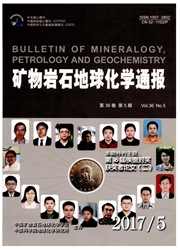

 中文摘要:
中文摘要:
本文研究了针铁矿、纤铁矿、赤铁矿和磁铁矿在过氧化氢参与下催化分解苯酚的动力学速率与溶液pH值的关系,并用紫外吸收谱测定了反应产物的谱学特征。结果表明,纤铁矿反应体系催化分解苯酚的速率常数(女)最大,其余依次为磁铁矿、针铁矿和赤铁矿。在纤铁矿反应体系中又以pH=3.8时反应速率常数最大。除赤铁矿反应体系外,当溶液pH=3~4时苯酚被完全分解,并有50%~65%的有机碳(TOC)被矿化。在pH=3.25的赤铁矿反应体系中,苯酚大多仅被转化为多酚,小部分苯环被打开形成己烯酸。当溶液pH=4~5时,苯酚一般仅被转化为多酚类化合物,但TOC基本不变。当溶液pH〉5时,苯酚没有发生明显的转化和矿化现象。
 英文摘要:
英文摘要:
The relationship between the kinetic rates of catalytic oxidation of phenol, by H2O2 with goethite,lepidocrocite, hematite and magnetite in aqueous solutions at pH=3-6 under normal room temperature, and the pH values of solutions has been investigated in this study. The spectrum characteristics of the decomposing products were determined by using ultraviolet spectrometry. The experimental results indicate that the constant k values for kinetic rates of the catalytic decomposition of phenol in various reaction systems are decreased subsequently from the lepidocrocite reaction system, to the magnetite, the goethite, and to the hematite reaction system. The biggest k value for kinetic rate of the catalytic decomposition of phenol is obtained in the lepidocrocite reaction system at pH value of 3.8 for the solution. The ultraviolet spectra and TOC (total organic carbon) analysis of the decomposing products suggest that the phenol was completely decomposed to carboxylic acids and about 50%-65% of TOC was mineralized in the lepidocrocite, the magnetite, and the goethite reaction systems respectively at pH values of 3-4 for the solutions. However, most of phenol was transformed to polyphenols, such as catchol or hydroquinone, only minor was degraded to hexalene acid in the hematite reaction system at pH value of 3.25 for the solution. When the pH values of solutions are in range of 4-5, the phenol was only transferred to polyphenol such as catechol and hydroquinone, and TOC was basically not mineralized for the reaction system of goethite. When pH values of solutions are larger than 5, the phenol in solution was neither transferred to polyphenol nor be mineralized in all iron oxide reaction systems.
 同期刊论文项目
同期刊论文项目
 同项目期刊论文
同项目期刊论文
 期刊信息
期刊信息
